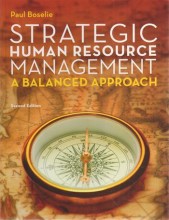Summary: Organizational Change Tentamenstof
- This + 400k other summaries
- A unique study and practice tool
- Never study anything twice again
- Get the grades you hope for
- 100% sure, 100% understanding
Read the summary and the most important questions on Organizational change tentamenstof
-
1 Lecture 1 Approaches to change
This is a preview. There are 1 more flashcards available for chapter 1
Show more cards here -
1.2 Van der Ven & Poole - Alternative approaches to study change
This is a preview. There are 4 more flashcards available for chapter 1.2
Show more cards here -
Van der Ven & Poole determined four different approaches on studying change, based on ontological and epistemological differences. Elaborate on this.
Theontological differences are based on:
- Theworld is made of things. From this perspectivechange isstudied asone state to the other state. Change inorganizations is anoun .
- Theworld is made of processes thatrestructure one another. Change inorganizations is averb .
The epistemological differences are based on:
- Variance method; the relation between independent and dependent variable. The aim is to explain/predict.
- Process method; the sequence of events that unfold over time. -
Given the four approaches of Van der Ven & Poole, what's the difference regarding time?
Approach 1: time is not an active part of the process, but rather a medium.
Approach 2: Time occurs when events occur.
Approach 3: Time is part of constructions
Approach 4: Time is the independent variable that produces the patterns we see. -
2 Lecture 2 Diagnosing the need for change
This is a preview. There are 1 more flashcards available for chapter 2
Show more cards here -
2.1 Lecture notes
This is a preview. There are 1 more flashcards available for chapter 2.1
Show more cards here -
What's the difference between diagnosis and diagnosing?
Diagnosis is thejudgement about what the problem is after examining. It's the process of understanding how and organization functions and provides information to designinterventions . Its about what elements shape peoples minds.
Instead, diagnosing is about how individuals as part of a collectivecommit themselves to a single frame as a basis ofsense making and coordinated actions. Its about sense making. By looking at how people frame things, you can understand how people come to certain actions. -
There are different levels of diagnosis. How does the diagnosis relate to the paper of Palmer and Dunford?
Diagnosis can be placed on the top side of the model. -
How is the paper of Cornelissen et al related to diagnosing?
This paper is related to diagnosing because it shows how commitment to a collective frame builds up and may come to overrule reflective thought. It shows us how people frame circumstances and how this (can) affects the interpretation and actions. -
How is the paper of Kaplan related to diagnosing?
This paper is about how actors transform own cognitive frames into organizational pre-dominant frames through daily interaction. -
Kaplan distinguishes diagnostic and prognostic. What's the difference?
Diagnostic - Understanding the problem
Prognostic - Understanding the solution -
2.2 Kaplan - Framing contests: Strategy making under uncertainty
This is a preview. There are 3 more flashcards available for chapter 2.2
Show more cards here -
Frames and framing are related to the framing contest model of Kaplan (2008). What's the difference?
Frames are the lenses through which people see the environment, problems and possible solutions. It are the means by which managers make sense of ambiguous information from the environment.
Framing is the active process to make a cognitive (individual) frame the dominant collective frame. -
How can frames structure outcomes according to Kaplan (2008)?
Frames can only structure outcomes to the degree that they were shared on a collective level. -
Frames affect information gathering, analysis and interpretation. How are frames related to diagnosis and prognostic aspects?
Diagnostic; aspects of frame attributes to contribute to the understanding of the problem.
Prognostic; aspects of the frames, based on the diagnosis, to know what solution to apply.
- Higher grades + faster learning
- Never study anything twice
- 100% sure, 100% understanding
Topics related to Summary: Organizational Change Tentamenstof
-
Diagnosing the need for change - Cornelissen et al., The contraction of meaning: the combined effect of communication, emotions and materiality on sense making
-
Internal drivers to change: issue selling
-
Social change in and between organizations - Howard-Grenville (2015) Peer-driven occupational change
-
Social change in and between organizations - DeJordy et al (2020) Inhabited ecosystems
-
Roles of a change agent
-
Institutional work
-
Perspectives on resistance - Lecture notes
-
Perspectives on resistance - Ford et al (2008) Resistance to change - the rest of the story
-
Organisations as barriers to change
-
Change and (unintended consequences) - Mantere & Schildt (2012) Reversal of strategic change

































